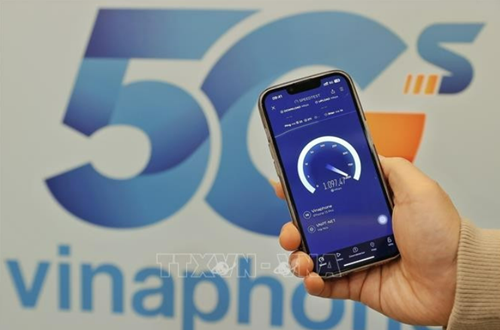According to Le Thai Hoa, Deputy Director of the Authority of Radio Frequency Management (ARFM) under the Ministry of Science and Technology, the rollout and development of 5G in Vietnam not only provide technological advantages but also act as a key driver of sustainable economic growth. This advancement enhances the country’s competitiveness and accelerates its industrialization and modernization processes.
    |
 |
|
Operating on the 3.700 - 3.800 MHz frequency band, VinaPhone 5G is the fastest internet service in Vietnam. |
5G infrastructure is seen as a vital foundation to enable breakthrough technologies such as the Internet of Things (IoT) and Artificial Intelligence (AI). With ultra-high speeds, extremely low latency, and massive connectivity, 5G goes beyond a simple data upgrade. It fuels growth in sectors like health care, education, and manufacturing, while opening major opportunities for successful national digital transformation.
On February 19, the National Assembly passed Resolution No.193/2025/QH15, which pilots special mechanisms and policies to advance science, technology, innovation, and digital transformation. The resolution includes provisions to support telecom firms investing in 5G infrastructure. Specifically, the government will cover up to 15% of total investment costs if a provider installs at least 20,000 base stations in 2025.
On March 1, Prime Minister Pham Minh Chinh issued Directive No.05/CT-TTg on solutions to boost economic growth, urging the acceleration of 5G commercialization and the development of high-speed broadband as new growth engines.
Vietnam’s 5G strategy has been clearly outlined in national digital technology and infrastructure policies. A wide range of solutions is being vigorously implemented to achieve the target of an average internet speed of 100 Mbps by 2025 and full nationwide 5G coverage by 2030.
Frequency spectrum is regarded as a strategic resource and the backbone of telecommunications. Vietnam has issued key plans focusing on strategic frequency bands such as 2600 MHz, 3700 MHz, sub-1 GHz, and 700 MHz. In total, nearly 1,000 MHz in the 6 GHz band has been allocated for mobile telecommunications.
Following spectrum allocation, telecom providers quickly moved to roll out and commercialize 5G services, with an expected contribution of 7.3-7.4% to national GDP in 2025. Viettel began commercial 5G services in October 2024, followed by VNPT in December, and MobiFone in March 2025.
As of May, Viettel, VNPT, and MobiFone had deployed around 11,000 5G base stations across all provinces and cities nationwide, reaching about 26% of the population, according to the ARFM. Based on current plans, the number of 5G stations is projected to reach 68,000 by the end of 2025, extending coverage to 90% of the population.
Viettel aims to install 20,000 5G base transceiver stations (BTS) by the end of this year.
VNPT has completed 5G coverage in central areas of all provinces and key locations such as industrial zones, airports, and political centers. It has also partnered with foreign technology firms to develop a 5G business strategy and explore new cooperation opportunities in fields like data centers, AI factories, network APIs, satellites, and vertical applications. The group is also promoting 4G/5G infrastructure sharing with other carriers to reduce costs and expand coverage.
MobiFone is focusing on 5G deployment in major urban centers and accelerating rollout in strategic areas, especially Ho Chi Minh City. It aims to build an additional 10,000 base stations to bring 5G coverage to 100% of communes nationwide.
According to the ARFM, the deployment of mid-band 5G has significantly improved Vietnam’s mobile broadband access speed, helping the country enter the global top 20 for the first time in the first quarter of this year, a 2.9-fold increase compared to the same period last year.
In April, the Ministry of Science and Technology issued Circular No.02/2025/TT-BKHCN on spectrum channel planning for fixed services in the 71-76 GHz and 81-86 GHz bands (known as the E band), facilitating the deployment of ultra-high-speed transmission infrastructure, a critical component of nationwide 5G development.
Source: VNA